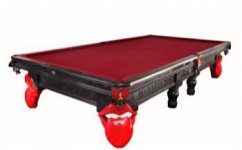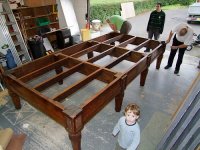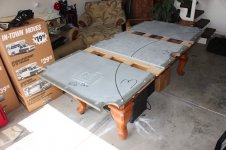You are using an out of date browser. It may not display this or other websites correctly.
You should upgrade or use an alternative browser.
You should upgrade or use an alternative browser.
Do pool tables frame need cross beams AND center beams.
- Thread starter preacherman
- Start date
sddale2001
Registered
Center beam too.
Yeah I would want both types of beams. It provides more support, which in turn will allow more options when it comes to shimming, and leveling the slates. Slate will flex some, so with that in mind you can see how it would be beneficial at times to shim the center of a piece to reduce, or eliminate a low spot, and without a center beam that would be impossible.
I could comment, but I doubt most will agree, because you all envision what a frame should be like, without the knowledge of leveling slates, or just how much they can be manipulated. To back up my point, none of you can figure out how a 3 piece slate can be installed on a frame....yet not mounted to it.
I could comment, but I doubt most will agree, because you all envision what a frame should be like, without the knowledge of leveling slates, or just how much they can be manipulated. To back up my point, none of you can figure out how a 3 piece slate can be installed on a frame....yet not mounted to it.
I could comment, but I won't.
If you want to see another style, steel long beams, wood across.

And yet, the outside frame still carries 100% of the weight of the slate and rails, don't matter how much frame work is in the middle...its all connected to the 4 outside frame boards.
Do pool tables (3 piece slate) need cross beams ONLY or should a pool table frame have a center beam for support of the slate.
Thanks,
Jim "preacherman"
Does a truck need 4 wheel drive? It depends on what the intended use is.
And yet, the outside frame still carries 100% of the weight of the slate and rails, don't matter how much frame work is in the middle...its all connected to the 4 outside frame boards.
Glen...did you ever see a nine-legged table?
An old Turkish guy in Montreal showed me a picture of one about 30 years ago....
...it was a Turkish carom 5x10 table.
Think it’s a good idea?
....middle three legs right down the center
Glen...did you ever see a nine-legged table?
An old Turkish guy in Montreal showed me a picture of one about 30 years ago....
...it was a Turkish carom 5x10 table.
Think it’s a good idea?
....middle three legs right down the center
9 legs is compensation for a weaker frame.
And yet, the outside frame still carries 100% of the weight of the slate and rails, don't matter how much frame work is in the middle...its all connected to the 4 outside frame boards.
Well, sure. For that matter it's all carried ultimately by 48 square inches of floor.
I was just offering another photo, I'm certainly not competent to comment on design. I'm just happy whoever designed it, and the guys that installed it, seemed to make it all work right and the balls roll straight.
I feel like I suddenly am in an argument I didn't know existed. Sorry.
9 legs is compensation for a weaker frame.
Gotta feeling it would be hell to level.
I could comment, but I doubt most will agree, because you all envision what a frame should be like, without the knowledge of leveling slates, or just how much they can be manipulated. To back up my point, none of you can figure out how a 3 piece slate can be installed on a frame....yet not mounted to it.
I agree with your mod but wish it could be done by anyone with decent skills.
It’s hard and expensive to have only one of your kind.
Maybe you can sell “kits”? Probably too much potential for dozens of phone calls from people needing “tech” help?!
Do you ever see a manufacturer using your leveling system? For a fee of course.
As far as not being able to envision.....
I’m going to try....
Slate attaches to your leaving system “frame”.
That floats on top of the original table frame.
I wish we could see it, but then people would try to copy it.
Your the Man, Glen.
The point is that slate is not infinitely stiff and most likely not dead flat. Of course more distributed support and a larger number of points to adjust it are better.
Sent from my SM-G950U using Tapatalk
I would tend to agree, I'm looking at a used table 9' for cheap (under $600) by Atlantic Billiards Corporation. I just not sure what I think of no center beam.
It played pretty nice, should I go for it not??
I would tend to agree, I'm looking at a used table 9' for cheap (under $600) by Atlantic Billiards Corporation. I just not sure what I think of no center beam.
It played pretty nice, should I go for it not??
A pic would be nice to see.
Seems like this might be the company that built a 6x12 for The Rolling. Stones when they
were in Atlanta in the middle 90s....it’s said the slate weighs 1,400 lbs....
....so they must know how to make a solid table.

Ok, the weight of the slate sits on the perimeter framework, the leveling of the slate has nothing persay to do with the amount of crossmembers or what they're made of, if they're connected to the perimeter framework, then all those crossmembers you guys are thinking is needed, won't stop a table frame from being swayback end to end under the weight of the slate...think about it. The strength of the frame in a pool table, is the primary support structure design, the exterior framework. In fact, it's better that the slate DONT touch anywhere in the center of the frame as to allow the slate to sit as flat as possible on the outside structural support, instead of the internal supports, that way the crossmembers are not in the way of the slate sitting flat. If in such case the center of the slate is low from side to side, THAT is what the crossmembers are for, to provide a place in order to provide some lift to the center of the slate by way of pushing up off the crossmembers in order to lift the center of the slate....which in itself, requires very little effort to lift the center of the slate, only a few pounds of force is needed in most cases, which equals the effort to pull down a high centered slate if crowned....but good luck doing that when all those crossmembers you feel a table needs....interfere with pulling the slate down flat, the best you can hope for is to hold the center down while you then go around and raise the outside edges of the slate to compensate for the crowning. The only place slate should actually have any contact on the frame, is around the perimeter framework, the rest of all that so called framework should have at least a 1/8" gap from the slate as to NOT interfere with its leveling, then it should only be used as necessary!!!!
Ok, the weight of the slate sits on the perimeter framework, the leveling of the slate has nothing persay to do with the amount of crossmembers or what they're made of, if they're connected to the perimeter framework, then all those crossmembers you guys are thinking is needed, won't stop a table frame from being swayback end to end under the weight of the slate...think about it. The strength of the frame in a pool table, is the primary support structure design, the exterior framework. In fact, it's better that the slate DONT touch anywhere in the center of the frame as to allow the slate to sit as flat as possible on the outside structural support, instead of the internal supports, that way the crossmembers are not in the way of the slate sitting flat. If in such case the center of the slate is low from side to side, THAT is what the crossmembers are for, to provide a place in order to provide some lift to the center of the slate by way of pushing up off the crossmembers in order to lift the center of the slate....which in itself, requires very little effort to lift the center of the slate, only a few pounds of force is needed in most cases, which equals the effort to pull down a high centered slate if crowned....but good luck doing that when all those crossmembers you feel a table needs....interfere with pulling the slate down flat, the best you can hope for is to hold the center down while you then go around and raise the outside edges of the slate to compensate for the crowning. The only place slate should actually have any contact on the frame, is around the perimeter framework, the rest of all that so called framework should have at least a 1/8" gap from the slate as to NOT interfere with its leveling, then it should only be used as necessary!!!!
Thanks for sharing. What you shared is one of the logical arguments. Why do any tables put center beams if not necessary?
Last edited:
Thanks for sharing. What you shared is one of the logical arguments. Why do any tables put center beams if not necessary?
The only purpose for crossmembers or center beams is to provide some sort of support to push up, or pull down the slate in order to match the seams, or to provide additional leveling. They are not needed to support the weight of the slate, as that is done with the perimeter framework.


